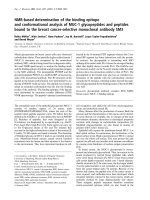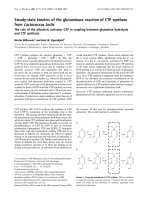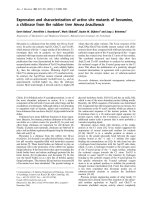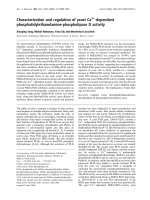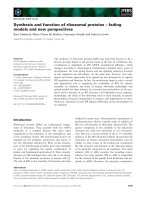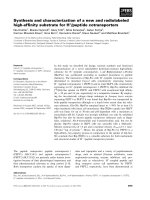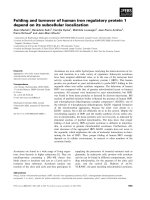Báo cáo Y học: Synthesis and turn-over of the replicative Cdc6 protein during the HeLa cell cycle potx
Bạn đang xem bản rút gọn của tài liệu. Xem và tải ngay bản đầy đủ của tài liệu tại đây (222.72 KB, 7 trang )
Synthesis and turn-over of the replicative Cdc6 protein
during the HeLa cell cycle
Esther Biermann, Martina Baack, Sandra Kreitz and Rolf Knippers
Department of Biology, Universita
¨
t Konstanz, Germany
The human replication protein Cdc6p is translocated from
its chromatin sites to the cytoplasm during the replication
phase (S phase) of the cell cycle. However, the amounts of
Cdc6p on chromatin remain high during S phase implying
either that displaced Cdc6p can rebind to chromatin, or that
Cdc6p is synthesized de novo. We have performed metabolic
labeling experiments and determined that [
35
S]methionine is
incorporated into Cdc6p a t similar rates during the G1 phase
and the S phase of the cell cycle. Newly synthesized Cdc6p
associates with chromatin. Pulse–chase e xperiments show
that chromatin-bound newly synthesized Cdc6p has a half
life of 2 –4 h. The r esults indicate that, once bound to
chromatin, pulse-labeled n ew C dc6p behaves just as old
Cdc6p: it dissociates and eventually disappears from the
nucleus. The data suggest a surprisingly dynamic behaviour
ofCdc6pintheHeLacellcycle.
Keywords: cell cycle; DNA replication; hCdc6; phospho-
rylation; turn-over.
The eukaryotic replication initiation protein Cdc6 (Cdc6p)
is a member of the large AAA
+
family of ATPases [1]. Like
other members of this family, Cdc6p possesses a bipartite
purine nucleoside triphosphate binding domain consisting
of the conserved Walker A and Walker B motifs. In
addition, Cdc6p contains several potential phosphorylation
sites in t he N-terminal region. C dc6p is required f or the
formation of pre-replicative c omplexes and therefore essen-
tial for replication initiation i n eukaryotic cells.
Pre-replicative complexes are assembled in a stepwise
manner during the G1 phase of the eukaryotic cell cycle.
Cdc6p associates with the chromatin-bound six-subunit
origin recognition complex (ORC) and promotes, together
with the Cdt1 protein [2,3], the subsequent loading of the
Mcm protein complex. The fully assembled pre-replicative
complex is induced to activate replication origins by at least
two c lasses o f protein phosphorylating e nzymes, c yclin-
dependent kinases (Cdk) and t he Dbf4-Cdc7 kinase [ 4–6].
In yeasts, Cdc6p is expressed during the G1 phase [7,8],
associates with stationary ORC [9,10] and loads Mcm
initiation proteins in reactions requiring an intact nucleotide
binding domain [11–13]. Once replication begins, yeast
Cdc6p is phosphorylated and then rapidly destroyed b y
ubiquitin-mediated protein degradation. The regulated
destruction of Cdc6p effectively prevents the binding of
Mcm proteins, and therefore prevents the re-replication of
DNA sections that had already replicated during the same S
phase [14–22]. In fact, overexpression of the wild-type
Cdc6p homolog (cdc18) in the yeast Schizosaccharomyces
pombe [17], and certain mutant alleles of the Saccharomyces
cerevisiae gene CDC6 induce the repeated activation of
replication origins within one cell cycle [23]. Normally,
however, the amounts o f Cdc6p fluctuate across the yeast
cell cycle. They rapidly decrease w ith the entry of yeast cells
into S phase and increase again during t he following G1
phase with the synthesis of new Cdc6p.
In contrast, the rapid S-phase-related elimination of
Cdc6p that is characteristic for the yeast cell cycle does not
occur i n mammalian cells, and levels of human Cdc6p
(hCdc6p) in cycling human cells remain fairly stable during
S phase, G2 phase and mitosis [24–27], but lower a mounts
of hCdc6p are present in early G 1 phase cells when hCdc6p
is rapidly degraded by ubiquitin-dependent proteolysis
[28,29]. Although more recent data suggest that t he reported
rapid degradation could be an extraction artefact [30].
Nuclear hCdc6p is phosphorylated during S phase
[27,31,32] and transported to the cytoplasm [31]. However,
at the same time, a considerable portion of hCdc6p is found
to be bound to chromatin [29], and it has been argued that
hCdc6p does not only serve as a l oading factor for M cm
proteins in human cells, but performs additional functions
during replication. This was concluded because ectopic
expression or microinjection of mutant hCdc6p lacking the
phosphorylation s ites interferes with DNA replication
[27,32]. A continuous requirement of hCdc6p for mamma-
lian genome replication may explain w hy hCdc6p is present
until the end of a c ell cycle.
The fact that the amounts of hCdc6p on chromatin
remain fairly constant during S phase while considerable
fractions are translocated to the cytoplasm implies t hat
enough hCdc6p must always be synthesized to replace the
fraction of hCdc6p that dissociates from chromatin during
S phase. T o investigate this possibility we have m etabolically
labeled hCdc6p and followed its fate in cycling HeLa cells
by pulse–chase experiments. We found that hCdc6p is
synthesized at similar rates during various stages o f t he cell
cycle, and determined a half life of newly synthesized
hCdc6p of 2–4 h in S phase. The data suggest a surprisingly
dynamic behaviour of hCdc6p in the HeLa cell cycle.
Correspondence to E. Biermann, Department of Biology, Universita
¨
t
Konstanz, D-78457, Konstanz, Germany. Fax: + 49 7531 88 4036,
Tel.: + 49 7531 88 2127,
E-mail:
Abbreviations: ORC, origin recognition complex.
(Received 22 October 2001, revised 17 D ecember 2001, accepted
19 December 2001)
Eur. J. Biochem. 269, 1040–1046 (2002) Ó FEBS 2002
EXPERIMENTAL PROCEDURES
Cell culture
Human HeLa S 3 cells were grown on plastic dishes in
Dulbecco’s modified Eagle’s m edium plus 5% fetal bovine
serum. Cells were s ynchronized at the beginning of S phase
by a double-thymidine procedure (12 h in 2.2 m
M
thymi-
dine; 9 h w ithout thymidine; 14 h in 2.2 m
M
thymidine) or at
mitosis with a nocodazole block (12 h in 2.2 m
M
thymidine;
9hrelease;3hat40ngÆmL
)1
nocodazole). The block was
released by washing c ells three times with medium.
For metabolic labeling, cells on 94-mm plates were
washed with methionine-free med ium (Gibco, Life T ech-
nologies) and labeled with 20 0 lCi [
35
S]methionine (ICN)
for 2 h in 5 mL methionine-free medium with d ialysed
bovine serum. For a chase, t he radioactive medium was
removed, and cells were washed several times with normal
medium and then grown un der standard conditions.
For proteasome inhibition, HeLa cells were synchronized
by a double t hymidine-block and released into f resh
medium with 5 l
M
MG-132 (Calbiochem) for 6 h.
Cell fractionation
Cells were washed with phosphate-buffered saline (NaCl/P
i
)
and suspended in buffer A (20 m
M
NaCl; 5 m
M
MgCl
2
;
1m
M
ATP; 20 m
M
Hepes, pH 7.5). After 15 min on ice and
douncing, cells were centrifuged to separate the cytosolic
supernatant f rom t he nuclear pellet. Nuclei were resus-
pended in buffer A with 0.5% NP40 and kept on ice for
15 min to lyse the nuclear envelope. Centrifugation yielded
supernatant nucleosolic proteins and an insoluble nuclear
pellet including chromatin. To dissociate bound proteins,
the nuclear pellet was washed with buffer B (0.3
M
sucrose;
0.5 m
M
MgCl
2
;1m
M
ATP; 20 m
M
Hepes, pH 7.5) plus
NaCl in concentrations of 0.1–0.45
M
as indicated below.
All extraction buffers contained phosphatase inhibitors:
1m
M
NaF, 1 m
M
vanadate and an EDTA-free protease
inhibitor cocktail in concentrations suggested by the man-
ufacturer (Roche Molecular B iochemicals).
For n uclease treatment, nuclei, prepared as above, were
resuspended in buffer B supplemented with 2 m
M
CaCl
2
and 100 m
M
NaCl and incubated for 10 min with 30 U
micrococcal nuclease at 1 4 °C. Digested chromatin was
recovered in the supernatant (S1) of low speed centrifuga-
tion. The pellet was resuspended in 5 m
M
EDTA and again
centrifuged to obtain supernatant S 2 a nd a pellet [ 33,34].
The supernatants and pellets were investigated by Western
blotting using hCdc6p-specific antibodies (see below) and
used for the extraction of DNA. E xtracted DNA was
analysed by PAGE and ethidium bromide st aining.
Preparation and use of antibodies
A cDNA sequence encoding a 30-kDa-fragment (amino-
acid residues 278–561) of hCdc6p was cloned in the
expression vector pRSET (Invitrogen) a nd expressed in
bacteria. The purified polypeptide was used as an antigen to
raise a ntibodies in rabbits. Monospecific antibodies were
prepared from the crude antisera by affinity chromatogra-
phy with the antigen immobilized on the SulfoLink gel
(Pierce).
For immunoblotting (Western blotting), proteins were
first separated on a 7.2% denaturing polyacrylamide gel and
then transferred onto a Protran nitrocellulose transfer
membrane (Schleicher and Schuell). For staining, hCdc6p-
monospecific antibodies (0.22 lgÆlL
)1
)wereusedina
1 : 200 dilution and visualized by goat anti-rabbit Ig
(Jackson Immuno Research) with the enhanced chemi-
luminescence system (ECL) as suggested by the manu-
facturer (Amersham Pharmacia B iotech).
Immunoprecipitations were performed with extracts
from 4–6 · 10
6
cells incubated w ith 2 lg h Cdc6p-specific
antibodies for 1 h on i ce. Protein A–Sepharose bead s (50 lL
of a 50% suspension; Amersham, Pharmacia Biotech) were
then added f or 1 h. The immunocomplexes were precipi-
tated and washed several times with 0.45
M
NaCl in buffer B
on ice. Proteins were eluted in Laemmli electrophoresis
buffer and investigated by denaturing PAGE as above.
Phosphatase treatment
Immunocomplexes were washed first with 0.45
M
NaCl in
buffer B as above and then with phosphatase buffer
(100 m
M
NaCl; 0.1 m
M
MnCl
2
;0.1m
M
EGTA; 50 m
M
Tris/HCl, pH 7.5). Treatment with lambda protein phos-
phatase (400 U; New England BioLabs) was in 0.05 mL
bufferfor30minoniceand30minat30°C under shaking.
The immunocomplexes were then washed in 0.45
M
NaCl
buffer B and processed f or electrophoresis as described
above.
RESULTS
HCdc6p on chromatin
We have prepared monospecific antibodies against recom-
binant hCdc6 protein. T o demonstrate their specificity and
efficiency, we presen t immunoblotting (Western) experi-
ments showing t hat the antibodies specifically recognize the
antigen in crude extra cts of bacteria expressing his-t agged
hCdc6p (Fig. 1A, lane 1). Western blots o f whole protein
extracts from HeLa cells frequently resulted in two bands
(Fig. 1A, lane 2), but, as control e xperiments showed, only
the upper band corresponded to hCdc6p whereas the lower
of the two bands was unspecific (because the secondary
mouse anti-rabbit Ig react with an unknown cellular protein
(Fig. 1A, lane 3). We analysed by i mmunoblotting the
distribution of hCdc6p in t he cytoplasm a s well as in t he
fractions of soluble (nucleosolic) and structure-bound
nuclear proteins (chromatin) from a synchronously prolifer-
ating HeLa cells. Chromatin-bound hCdc6p could be
mobilized in buffers with 0.25–0.45
M
NaCl (Fig. 1B) and
was effectively i mmunoprecipitated by h Cdc6p-specific
antibodies (Fig. 1C).
We note that 0.25–0.45
M
NaCl is also required to
dissociate human Orc proteins from chromatin [34], and the
question arises w hether human Orc1p and hCdc6p in the
salt-extracts are bound to each other as both proteins are
known to physically interact under in vitro conditions
[25,32]. However, we were unable to detect coimmunopre-
cipitations of hCdc6p and hOrc1p (or other Orc proteins)
using e ither hCdc6p- or hOrc1p-specific antibodies (not
shown). This does not exclude the possibility that the two
proteins interact when b ound to chromatin. In fact, w e
Ó FEBS 2002 The fate of hCDC6p during the HeLa cycle (Eur. J. Biochem. 269) 1041
determined that hCdc6p resides in a nuclease-resistant
compartment of chromatin (data not shown) [26] just like
hOrc1p and hOrc2p as previously shown [34]. It is therefore
possible that hCdc6p together with other replication
initiation proteins occur in l arge protein c omplexes that
protect DNA against nuclease attack, but dissociate a t high
salt concentrations (Fig. 1B).
In the e xperiments reported b elow, we prepared H eLa
cell extracts a s in Fig. 1B and separated a cytos olic fraction
from the nuclear fraction w hich w as t hen t r eated w ith
0.45
M
NaCl to mobilize chromatin-bound h Cdc6p. The
presence of hCdc6p in these preparations was determined by
immunoprecipitation.
Rates of hCdc6p synthesis
To investigate w hether the synthesis of hCdc6p was
restricted to specific phases of t he c ell cyc le, He La cells
were arrested by a double-thymidine procedure at the G1
phase/S phase transition, and then released i nto the cycle
after removing e xcess thymidine. Cells were labeled with
[
35
S]methionine for 2 h at the beginning (0–2 h after
thymidine-block) and in the middle of S phase (4–6 h), as
well as at the e nd of mitosis and during the early G1 phase
(12–14 h) of the next cycle (Fig. 2A).
Cytoplasmic and chromatin e xtracts were immunopre-
cipitated with s pecific antibodies an d transferred to n itro-
cellulose membranes. Immunostaining showed that cells in
all cell cycle phas es possess substantial amounts o f chroma-
tin-bound hCdc6p although the amount of chromatin-
bound hCdc6p appeared to be lower in early G1-phase
(Fig. 2B, right) [28,29]. Cytoplasmic hCdc6p was detected
mainly in S-phase cells in agreement with p revious work
which had shown that hCdc6p dissociates from chromatin
and migrates to the cytoplasm during S phase [25,31] (see
introduction) (Fig. 2B, left).
The membranes used for Western b lotting were washed
to remove the ECL reagent, dried a nd exposed to X-ray
films for autoradiography. T he results show that similar
amounts of [
35
S]methionine were incorporated into hCdc6p
during the cell cycle phases tested. Moreover, in all cases the
incorporated radioactivity w as almost evenly distributed
between the c ytoplasmic and the chromatin fractions of
hCdc6p (Fig. 2C).
We conclude that hCdc6p was syn thesized during the
four cell-cycle stages examined, and that about one half of
the newly synthesized hCdc6p associated with chromatin
during the 2-h label period.
Fig. 2 . Sy nthes is of h Cdc 6p. HeLa cells ( 1 · 10
7
), arrested by a do uble-
thymidine block, were released into the cell cycle. At the times indi-
cated, 4 · 10
5
HeLa cells were incubated with 15 lg propidium io dide
in 0.3 mL phosphate-buffered saline with 0.1% Triton X-100 for
30minoniceandprocessedforFACSanalysis(A).Theremaining
cells w ere l abeled with [
35
S]methionine for 2 h and then fractionated to
prepare cytosol (Cy) and nuclear extracts at 0.45
M
NaCl. Ext racts
were immunoprecipitated. Precipitated pr oteins were analysed by
Western blotting (B) and autoradiography (C).
Fig. 1. Characterization of antibodies and cell fractionation. (A) Identification of hCdc6p by immunoblo tting. Lane 1, H is-tagged recombin ant
hCdc6p; l ane 2, nuclear extracts pre pared at 0.45
M
NaCl staine d with h Cdc6p-spec ific antibodies; lan e 3, as in lane 2 except that only t he secondary
antibody w as used. (B) Cell fractionation (see Experimen tal procedures). Cy, cytosol; Nu, soluble nuclear proteins (nucleo sol); last three l anes,
extracts prep ared with 100, 250 and 450 m
M
NaCl from NP40-treated nuclei. The experiment w as performed with 2 · 10
6
HeLa cells. Five hundred
nanograms of protein per lane were investigated by immunoblotting. (C) Immunoprecipitation. A n uclear extract (2 · 10
6
cells) prepared a t
450 m
M
NaCl (input) was treated with 2 lg antibodies for immunoprecipitation. Equal aliquots of the supernatants and the immunoprecipitates
were immunoblotted and stained with hCdc6p-specific antibodies.
1042 E. Biermann et al. (Eur. J. Biochem. 269) Ó FEBS 2002
In most experiments, soluble labeled hCdc6p in S phase
appeared in two electrophoretic bands (Fig. 2C, left). The
labeled hCdc6p species in the upper band was phosphory-
lated because phosphatase-treatment converted it into t he
faster moving species (Fig. 3B). In c ontrast, the labeled
hCdc6p in early G1-phase always appeared in one faster
moving electrophoretic band (Fig. 2C, left panel) and was
therefore un- or underphosphorylated. The changes in the
electrophoretic mobilities of phosphatase-treated prepara-
tions indicate that not only labeled cytoplasmic hCdc6p, but
also labeled c hromatin-bound hCdc6p appears t o b e
phosphorylated during S phase (Fig. 3B) [26,28].
As in Fig. 3A,B we have repeatedly observed in other
similar experiments that more hCdc6p can be immunopre-
cipitated from phosphatase-treated nuclear extracts than
from control extracts of S -phase HeLa cells. A s a n
explanation, we considered the possibility that t he phos-
phorylated form of hCdc6p was prone to degradation
during the in vitro incubation. This could be due to
proteasome-mediated degradation. To investigate this pos-
sibility, we treated HeLa cells with the proteasome-inhibitor
MG-132 prior to the prepar ation of nuclear extracts. I n
these extracts, the phosphorylated hCdc6p in the control
sample was at l east as stable as the phosphatase-treated
hCdc6p (Fig. 3C) suggesting that nuclear extracts from
S-phase HeLa cellscontain a proteasome-related activity that
preferentially attacks the phosphorylated form of hCdc6p.
However, more importantly in th e present context, we
note that the synth esis of hCdc6p c ontinues through m ost of
the cell cycle. Synthesis of hCdc6p during G1 phase is
necessary f or the f ormation of pre-replicative complexes,
whereas s ynthesis during S phase may be needed to replace
that fraction of hCdc6p that is transferred to the cytoplasm
and eventually degraded. It can therefore be predicted that
the amounts of hCdc6p on chromatin increase during G1
phase, but remain unchanged during S phase because
de novo synthesis c ompensates for t he S-phase-dependent
loss of hCdc6p.
We have investigated this point using HeLa cells released
from a nocodazole b lock into G 1 and S p hase (Fig. 4A). We
found a gradual increase of chromatin-bound hCdc6p
during G1 phase followed b y a d ecrease in early S phase
[24]. With the continuation of S phas e, however, the amount
of hCdc6p on chromatin remained constant (Fig. 4C)
implying that newly synth esized hCdc6p (Fig. 2) first
associates with chromatin, and then turns over like old
hCdc6p. We have addressed this point performing pulse–
chase experiments.
Fate of newly synthesized hCdc6p
HeLa cells were r eleased from a double-thymidine block
and l abeled wit h [
35
S]methionine for 2 h. The radioactive
medium was t hen removed and r eplaced by s tandard culture
medium. Cells were collected immediately after the 2 -h-
pulse and after cultivation for several hours in medium with
excess methionine. Note that a 2-h-pulse-period under
methionine-free conditions causes a delay in cell cycle
progression with the consequence that cells are still in
S phase after a 8-h c hase period (not shown).
We present an experiment where the label period was 4–6
h after release f rom the thymidine block followed by chase
periods of 4 and 8 h (Fig. 5). Total h Cdc6p, as determined
by Western blotting, was similar in the pulse and in the
chase s amples (Fi g. 5A) whereas
35
S-labeled hCdc6p
decreased during the chase period ( Fig. 5B).
Just as shown in Fig. 2, about one half of the pulse-label
appeared in cytoplasmic hCdc6p, and the other half in
chromatin-bound hCdc6p. The phosphorylated upper-band
form of labeled cytoplasmic hCdc6p r apidly disappeared
during the chase (half life < 2 h, Fig. 5B, left). It can
assumed that p art of t he labeled c ytoplasmic hCdc6p moved
into the nucleus and bound to ch romatin, but another p art
may h ave remained in the c ytoplasm to be degraded or
Fig. 4. Soluble and chromatin-bound hCdc6p. Cells were arrested by
nocodazoleandthenreleasedintoG1andSphaseasmonitoredby
FACS analysis (A). Soluble n uclear and chromatin-bou nd proteins
(450 m
M
NaCl) were investigated by denaturing polyacrylamide gel
electrophoresis. C oomassie staining (B) served as a loading control and
Western blotting (C) to analyse for hCdc6p.
Fig. 3. Phosphorylated hCdc6p in S phase. HeLa cells (1 · 10
7
)were
released from a double-thymidine block, and labeled for 2 h with
[
35
S]methionine. Immunopre cipitates of cytosolic proteins (Cy) and of
nuclear extracts (450 m
M
NaCl) were incubated with buffer only or
with buffer p lus lambda phosphatase as indic ated. The proteins were
analysed by Western blotting (A) and autor adiography (B). Cells were
released from a double-thymidine block as above, but cultivated for 6 h
in the presence of the proteasome-inhibitor MG-132 before c ell frac-
tionation. Immunoprecipitates of cytosolic and nuclear proteins were
treated with phosphatase and investigated by Western blotting (C).
Ó FEBS 2002 The fate of hCDC6p during the HeLa cycle (Eur. J. Biochem. 269) 1043
converted into the more phosphorylated form (half life:
4 h) (Fig. 5B, left).
In either case, the amount of labeled chromatin-bound
hCdc6p decreased during the chase with an estimated half
life of 2–4 h (Fig. 5B, right). This value appears to be similar
for cytosolic and salt-extracted hCdc6p.
We have performed several pulse–chase experiments and
quantitated the results by densitometry to determine the
relative strengths o f t he autoradiographic signals in labeled
chromatin-associated hCdc6p. With t he pulse value taken
as 100% we determined that half of the labeled chromatin-
bound hCdc6p disappears during chase periods of 2–4 h
(Fig. 6).
A likely explanation is that a fraction of labeled
cytoplasmic hCdc6p is t ransferred to chromatin where i t
shares the fate of o ld hCdc6p, namely dissociation, trans-
port to the cytoplasm and degradation. Continued protein
synthesis guarantees that the amount of chromatin-associ-
ated hCdc6p remains h igh.
DISCUSSION
We show here that [
35
S]methionine is incorporated into
hCdc6p of HeLa cells at various times after release from a
thymidine-block, and conclude that hCdc6p is newly
synthesized at similar rates during most stages of the HeLa
cell c ycle. This information adds to the growing knowledge
of hCdc6p expression in mammalian cells.
The expression of hCdc6p in mammalian cells is strictly
associated with cell proliferation. Quiescent mammalian
cells fail to express Cdc6 m RNA and protein, but r eaddition
of serum to serum-starved cells and dilution of contact-
inhibited primary cells induce the expression of Cdc6p
[24,35,36]. This reaction is controlled by E2F transcription
factors [35] which are responsible for the expression of a
large number genes involved in DNA replicatio n. Once
proliferation has been initiated, mamm alian cells express
Cdc6 mRNA at all stages of the cell cycle with a several fold
increase in mRNA abundance at the onset of S phase
[25,28].
Consistent with the continuous pr esence of mRNA, levels
of Cdc6p remain high in poliferating human cells at most
stages of the cell cycle [24,25,27,35,37] although more recent
experiments suggest that the l evels of hCdc6p may below i n
early G1 cells due to the mitotic destruction of most hCdc6p
[28–30]. In spite of this, chromatin from nocodazole-
arrested HeLa cells still carries some hCdc6p (Fig. 4),
which is apparently required for an early loading of Mcm
proteins [29]. T he amount of hCdc6p on chromatin
increases after removal of nocodazole as cells traverse the
G1 phase [28,29] (Fig. 4). This was demonstrated here by
the incorporation of [
35
S]methionine.
More surprisingly, hCdc6p continues to be synthesized at
similar rates during S phase (Fig. 2). The b ehaviour of
mammalian Cdc6p during S phase has b een investigated
over the past few years. Williams et al. [24] have noted that
chromatin-bound hCdc6p decreases in S phase, and Saha
et al. [25] found hCdc6p in the nucleus during pre-replica-
tion phase, and in the cytoplasm after origins had started to
fire in S phase. The subcellular distribution of Cdc6p during
the cell cycle is m ost likely r egulated by phosphorylation [ 27]
involving the cyclin A-dependent protein kinase CDK2
which h as been shown to bind to and specifically phospho-
rylate mammalian Cdc6p [31,38]. However, in spite of the
S-phase-related nuclear–cytoplasmic transfer, substantial
amounts of mammalian Cdc6p remain on chromatin [29,39]
(Fig. 4 ). One reason for this is that hCdc6p is synthesized at
high rates during S phase (Fig. 2). In fact, we found that the
amounts o f pulse-labeled Cdc6p on chromatin were similar
in G1 phase and S-phase cells. This r esult s uggests that the
fraction of Ôold Õ hCdc6p that dissociates from chromatin
and is transferred to the cytoplasm during S phase is at least
partially replaced by newly s ynthesized hCdc6p.
Once bound to chromatin, pulse-labeled new hCdc6p
behaves just as old hCdc6p, i.e. it dissociates and eventually
disappears from the nucleus with a half life of < 4 h
(Fig. 6 ). This is substantially longer than the half life of
30 min m easured for hCdc6p at the mitosis/G1 phase
transition when a sudden massive destruction of Cdc6p
Fig. 6. Half-life of c hromatin-bound hCdc6p in S p hase. HeLa cells
were labeled with [
35
S]methionine for 2 h im mediately after release
from a double-thymidine block and chased for the times indicated
(squares). Proteins were extracted with 450 m
M
NaCl from chromatin
and analysed by immunoprecipitation and a utoradiography. T he
autoradiographic b ands were evaluate d by densitometry with the pulse
values taken a s 100%. Deviation bars give averages o f three inde-
pendent experiments. The results of the experiment in Fig. 5 are
included (circles).
Fig. 5. The fate of labeled hCDC6p. HeLa cells were first labeled with
[
35
S]methionine at 6 h after release from a d ouble- thymidine block and
then chased for 4 and 8 h as indicated. Cytosolic (Cy) and chromatin-
associated (4 50 m
M
NaCl) proteins were prepared and investigated by
immunoprecipitation. We sho w Western blot (A) an d autoradiogra-
phy (B) of the immunoprecipitates.
1044 E. Biermann et al. (Eur. J. Biochem. 269) Ó FEBS 2002
occurs that is closely f ollowed b y the synthesis o f new Cdc6p
[28]. Thus, synthesis follows degradation in early G1 phases
whereas the production of new hCdc6p s eems to occur
simultaneously with the displacement of old hCdc6p from
chromatin during S phase.
Why does hCdc6p go through a cycle of synthesis,
chromatin-binding and release within one S phase? This
must be somehow connected with functions that hCdc6p
performs in genome r eplication. One function is certainly
the assembly of the pre-replicatio n complex, but additional
functions seem to be required at or after the i nitiation of
replication. This has been concluded because the micro-
injection of mutant unphosphorylatable hCdc6p interferes
with DNA replication [32] and ectopic expression of mutant
hCdc6p leads t o a delay in S phase entry [27]. Therefore,
phosphorylation may be necessary for a S-phase related
function of hCdc6p, e.g. the activation of late origins.
Because phosphorylation also causes t he relocalization of
hCdc6p from the nucleus to the cytoplasm [22,24,27],
continued synthesis would be necessary to provide enough
hCdc6p for S phase progression. The S-phase function of
hCdc6p must be distinct from Mcm loading because Mcm
proteins dissociate from their chromatin sites during S
phase. Indeed, while hCdc6p may be necessary for Mcm
loading during G1 phase, it is certainly not sufficient
because the Cdt1 protein i s also i nvolved, and t he Cdt1
protein is e ffectively sequestered during S phase by th e
regulator protein geminin [40]. It will therefore certain ly b e
of interest to determine the biochemical function that
hCdc6p performs during S phase.
ACKNOWLEDGEMENTS
We thank C hristine Peinelt for composing Fig. 6. This work was
supported by Deutsche Forschungs-Gemeinschaft.
REFERENCES
1. Neuwald, A.F., Aravind, L., Spouge, J.L. & Koonin, E.V. (1999)
AAA+: a class of chaperone-like ATPases associated with the
assembly, operation, and d isassembly of protein com plexes.
Genome Res. 9, 27–43.
2. Maiorano, D., Moreau, J. & Mechali, M. (2000) XCDT1 is
required for the assembly of pre-replicative complexes in Xenopus
laevis. Nature 404, 622–625.
3. Nishitani, H., Lygerou, Z., Nishimoto, T. & Nurse, P. (2000) The
Cdt1 protein is required to license DNA f or replication in fission
yeast. Nature 404, 625–628.
4. Quintana, D.G. & Dutta, A. (1999) The metazoan origin
recognition complex. Front. B iosci. 4, D805–D815.
5. DePamphilis, M.L. (1999) Replication origins in metazoan
chromosomes: fact or fiction? Bioessays 21, 5–16.
6. Kelly, T.J. & Brown, G.W. (2000) Regulation of chromosome
replication. Annu.Rev.Biochem.69, 8 29–880.
7. Piatti, S., Lengauer, C. & Na smyth, K. (1995) Cdc6 is a n unstable
protein w hose de novo synthesis in G1 is important for t he onset
of S phase and for preventing a ÔreductionalÕ anaphase in the
budding yeast Sac charomyce s cerevisiae. EM BO J. 14, 3788–3799.
8. Drury, L.S., Perkins, G. & Diffley, J.F. (1997) The Cdc4/34/53
pathway targe ts Cdc 6p for proteolysis in budding yeast. EMB O J.
16, 5966–5976.
9. Li, J.J. & H erskowit z, I. (1993) Isolation of ORC6, a component
of the yeast origin re cognition complex by a one-hybrid system.
Science 262, 1870–1874.
10. Liang, C., Weinreich, M. & Stillman, B. (1995) ORC and Cdc6p
interact and determine the f requency of initiation of DNA
replication in the genome. Cell 81 , 667–676.
11. Perkins, G. & Diffley, J.F. ( 1998) Nucleotide-dependent prerepli-
cative complex assembly by Cdc6p, a homolog of eukaryotic and
prokaryotic clamp-loaders. Mol. Cell 2, 23–32.
12. Weinreich, M., Liang, C. & Stillman, B . (1999) The Cdc6p
nucleotide-binding motif is required for lo ading mcm proteins
onto chromatin. Proc. Natl Acad. Sci. USA 96 , 441–446.
13. Feng, L., Hu, Y., W ang, B., W u, L. & Jong, A. (2000) Loss control
of Mcm5 interaction with chromatin in cdc6–1 mutated in
CDC-NTP motif. DNA Cell Biol. 19, 447–457.
14. Piatti, S., Bohm, T., Cocker, J.H., Diffley, J.F. & Nasmyth, K.
(1996) Activation of S-phase-promoting CDKs in late G1 defines
a ‘‘p oint of no return’’ after which Cdc6 synthe sis c annot promo te
DNA replication in yeast. Ge nes Dev. 10, 151 6–1531.
15. Elsasser, S., Lou, F., Wang, B., Campbell, J.L. & Jong, A. (1996)
Interaction between yeast Cdc6 protein and B-type cyclin/Cdc28
kinases. Mol. Biol. Cell 7, 1723–1735.
16. Brown, G .W., Jallepalli, P.V., Huneycutt, B.J. & Kelly, T .J. (1997)
Interaction of t he S phase regulator cdc18 with cyclin-dependent
kinase in fission yeast. Proc. N atl Acad. Sci. USA 94 , 6142–6147.
17. Jallepalli, P.V., Brown, G .W., Muzi-Falconi, M., Tien, D. &
Kelly, T.J. (1997) Regulation of the replication initiator protein
p65cdc18 by CDK phosphorylation. Genes Dev. 11, 276 7–2779.
18. Kominami, K . & Toda, T. (1997) Fission yeast WD-repeat protein
pop1 regulates genome ploidy through ubiquitin-proteasome-
mediated degradation of the CDK inhibitor Rum1 and the
S-phase i nitiator Cdc 18. Genes Dev. 11, 1548–1560.
19. Baum, B., Nishitani, H., Yanow, S. & Nurse, P. (1998) Cdc18
transcription and proteolysis couple S phase to passage through
mitosis. EMBO J. 17, 5689–5698.
20. Sanchez, M., Calzada, A. & B ueno, A . (1999) The C dc6 protein is
ubiquitinated in vivo for p roteolysis in Saccharomyces cerevisiae.
J. Biol. Chem. 274, 9092–9097.
21. Calzada, A., Sanchez, M., Sanchez, E. & Bueno, A. (2000) The
stability of the Cdc6 protein i s regulated by cyclin-dependent
kinase/cyclin B complexes in Saccharomyces cerevisiae. J. Biol.
Chem. 275, 9734–9741.
22. Drury, L.S., Perkins, G. & Diffley, J.F. (2000) The cyclin-depen-
dent kinase Cdc28p regulates distinct modes of Cdc6p proteolysis
during the budding yeast cell cycle. Curr. Biol. 10, 231–240.
23. Liang, C. & Stillman, B. (1997) Persistent initiation of DNA
replication and c hromatin-bo und MCM proteins during the c ell
cycle in c dc6 mutants. Genes Dev. 11, 3375–3386.
24. Williams, R.S., Shohet, R.V. & Stillman, B. (1997) A human
protein related to yeast Cdc6p. Proc. Natl Acad. Sci. USA 94,
142–147.
25.Saha,P.,Chen,J.,Thome,K.C.,Lawlis,S.J.,Hou,Z.H.,
Hendricks, M., Parvin, J .D. & Dutta, A. (1998) H uman CDC6/
Cdc18 a ssociat es with Orc1 and cyclin-cdk and is selectively
eliminated from the nucleus at the o nset of S phase. Mol. Cell Biol.
18, 2758–2767.
26. Fujita, M. (1999) Cell c ycle regulation of DNA replication initi-
ation proteins in mammalian cells. Front Biosci. 4, D816–D823.
27. Jiang, W., Wells, N .J. & H unter, T. (1999) Multistep regulation of
DNA replication by Cdk phosphorylation of HsCdc6. Proc. Natl
Acad.Sci.USA96, 6193–6198.
28. Petersen, B.O., Wagener, C., Marinoni, F., Kramer, E.R.,
Melixetian,M.,Denchi,E.L.,Gieffers,C.,Matteucci,C.,Peters,
J.M. & Helin, K. ( 2000) Cell cycle- and cell growth-regulated
proteolysis of mammalian CDC6 is dependent on APC-CDH1.
Genes Dev. 14, 233 0–2343.
29. Mendez, J. & Stillman, B. (2000) Chromatin association o f human
origin recognition complex, cdc6, and minichromosome mainte-
nance proteins during the cell cycle: assembly of prereplication
complexes in late m itosis. Mol. Cell Biol. 20 , 8602–8612.
Ó FEBS 2002 The fate of hCDC6p during the HeLa cycle (Eur. J. Biochem. 269) 1045
30. Okuno, Y., McNairn, A.J., den Elzen, N., Pines, J. & Gilbert,
D.M. (2001) Stability, chromatin association and functional
activity of mammalian pre-replication complex proteins dur ing the
cell cycle. EMBO J. 20 , 4263–4277.
31. Petersen, B.O., Lukas, J., Sorensen, C.S., Bartek, J. & Helin, K.
(1999) Phosphorylation of mammalian CDC6 by cyclin A/CDK2
regulates its subcellular localization. EMBO J. 18, 396–410.
32. Herbig, U., Griffith, J.W. & Fanning, E. (2000) Mutation of
cyclin/cdk phosphorylation sites in HsCdc6 disrupts a late step in
initiation of DNA r eplication in human cells. Mol. Biol. Cell 11 ,
4117–4130.
33. Rose, S .M. & Garrard, W.T. (1984) D ifferentiation-dependent
chromatin a lterations precede and ac comp any transcription of
immunoglobulin light chain genes. J. Biol. Chem. 259, 8534–8544.
34. Kreitz, S., Ritzi, M., B aack, M. & Knippers, R. (2001) The
human origin recognition complex protein 1 dissociates from
chromatin during S phase in HeLa cells. J. Biol. Chem. 276,
6337–6342.
35. Yan, Z., DeGregori, J., Shohet , R., Leone, G., Stillman, B .,
Nevins, J.R. & Williams, R .S. (1998) Cdc6 is regulated b y E2F and
is essential for DNA replication in mammalian cells. Proc. Natl
Acad. Sci. USA 95, 3603–3608.
36. Stoeber, K. , Mills, A.D., Kubota, Y., Krude, T., Romanowski, P.,
Marheineke, K ., Laskey, R.A. & Williams, G .H. (1998) Cdc6
protein causes premature entry int o S phase in a mammalian
cell-free system. EMB O J. 17 , 7219–7229.
37. Fujita, M., H ori, Y., S hirahige, K., Tsurimoto, T., Y oshikawa, H.
& Obuse, C. (1 998) Cell cy cle d epen dent topo logical c hanges o f
chromosomal r eplication origins in Saccharomyces c erevisiae.
Genes Cells 3, 737–749.
38. Herbig, U ., Marlar, C.A. & Fanning, E. (1999) The Cdc6
nucleotide-binding site regulates its activity in DNA replication in
human cells. Mol. Biol. C ell 10, 2 631–2645.
39. Coverley, D., Pelizon, C., Trewick, S. & Laskey, R.A. (2000)
Chromatin-bound Cdc6 persists in S and G2 phases in human
cells, wh ile soluble Cdc6 is destroyed i n a cyclin A-cdk2 dependent
process. J. Cell Sci. 11 3, 1929–1938.
40. Wohlschlegel, J .A., Dwyer, B.T., D har, S.K., Cvetic, C., Walter,
J.C. & Dutta, A. (2000) Inhibition of eukaryotic DNA replication
by geminin binding to Cdt1. Science 290, 2309–2312.
1046 E. Biermann et al. (Eur. J. Biochem. 269) Ó FEBS 2002
